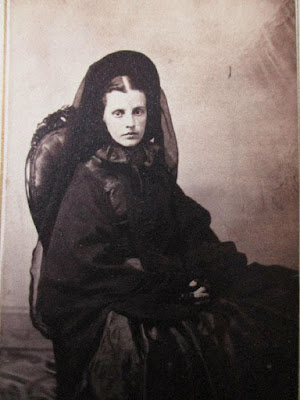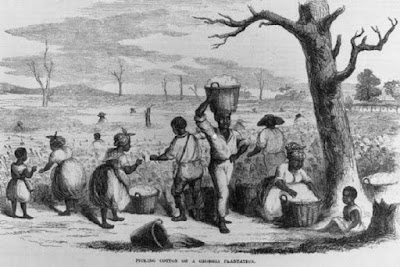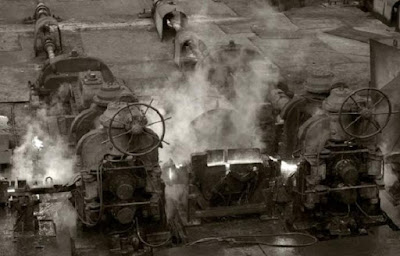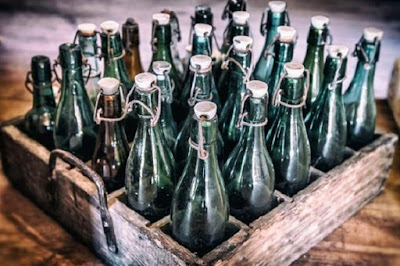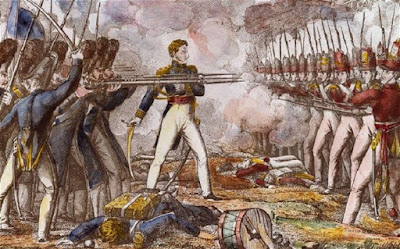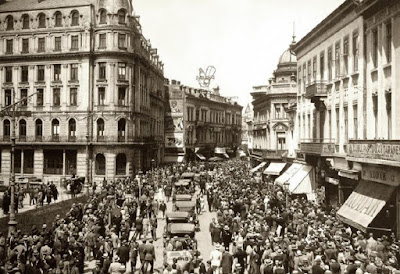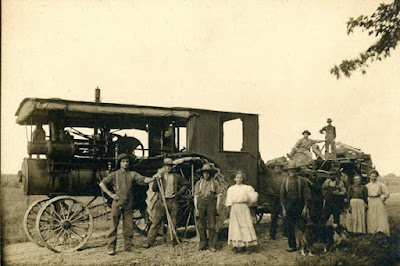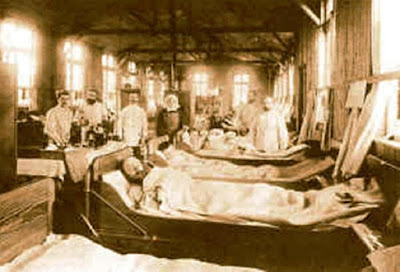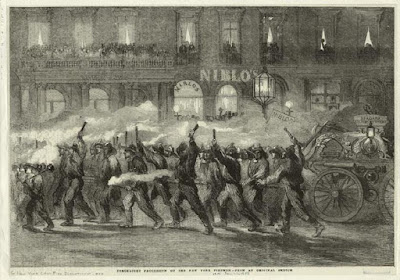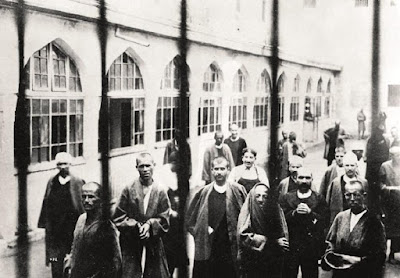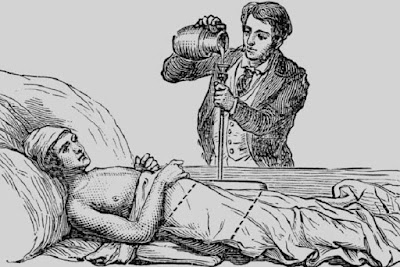People pine for the good old days, when humans somehow lived better, more fulfilling lives than they do today. The sad fact is that there were never any “good old days.” The only thing that has changed over time is our ability to express compassion for other living beings and the safety measures that we have put in place to help protect lives.
As a whole, we’ve forgotten what life was really like long ago. The 1800s, for example, were dangerous times when disease and lack of education could kill the innocent, the vulnerable, and even the strongest among us. Life was fragile, and death was always right around the corner.
20. Horse Transport In Cities Was Horrifying
Horse transportation, you know, like carriages and stuff, is usually depicted in movies and in our general imagination as the most romantic form of transportation. It’s like those fancy horse and buggies in Central Park, only all the time, right? How cool would that be? The answer is very, very uncool. First of all, let’s talk poop: those little attachments to catch the poop on today’s wagons did not exist. That resulted in poop from horses littering the streets pretty much everywhere you went.
Upper class women and men literally wore shoes with lifts on them because the streets were so coated in horse poop. Aside from the poop, another fun fact they don’t tend to discuss about horse travel is that they sometimes died. Like, just keeled over and died in the middle of the street. And because horses are so big, there was no quick or easy way to get them out of the street. This meant that people would often just leave the dead horse where it fell, where it would rot, bloat, and sometimes explode because of the build up of gasses in its abdomen.
19. Everything’s Awful For Ladies
In general, looking back on history, if you’re a lady, things aren’t great for you. The 19th century is no exception to that rule. Women were basically the property of men, be it their fathers or their husbands. They had no real options except to have kids – and to keep having kids – and many had to maintain both a household and a job at a factory. Women were expected to be submissive, and the fashion of the day did a good job as being as constricting as possible, between huge hoop skirts and corsets so tight they would constrict breathing and warp the ribs.
If you stepped out of line, your husband had every right to put you “in your place”. Women had very minimal access to education, and wouldn’t get the vote until the next century (good job, progress!), so weren’t even really considered full citizens. Oh, and if they thought you were too interested in sex, they could diagnose you as a hysteric and remove your uterus.
18. Slavery Was Still A Thing
Lest we forget, during a majority of the 19th century, people were still held as actual slaves. This is shocking even now, and the horrors of slavery are some of the worst things any human being could endure. There was the indignity of being someone else’s property, which meant you could be bought or sold at their leisure, and which also meant that they could buy or sell your wife, your husband, and/or your children at any time, with no regard for what that separation would mean to you. Then there’s obviously the forced labor, and the abuses that would happen up to and including death.
If there’s anything that truly makes the 19th century horrifying, it’s that people were legally allowed to own people – a notion that is truly nightmarish. Oh, and the kicker? Once the emancipation proclamation made slavery illegal, former slaves would still have to endure horrific racism and disenfranchisement, as would their descendents for generations to come. Up yours, 19th century, you garbage fire.
17. Mangled By Machinery
Working in the mills and factories before the age of safety regulations was deadly. Newspapers reported numerous instances of women, children, and men being mangled by exposed machinery.
Most of the accidents could have been prevented with appropriate clothing and safety barriers. For example, a young Wisconsin woman was inspecting the machinery in a flour mill in 1861 when “her clothing came in contact with an upright shaft.” She could not break free, and by the time word got out to shut down the mill, her body was “horribly mangled.”
In a report published in 1892, we learn that a young man was ground to death in a California paste factory. When he began to fix the “dough,” the wheel inside the paste tub spun and caught his hand. He was pulled in between the tub and the grindstone, where he was ground to death.
16. Medicine Was Terrifying
If we’re talking medicine here, we’re going to want to apply some very serious air quotes, because what passed for medicine in the 19th century was pretty awful, including a number of painful procedures that usually didn’t even cure what they set out to cure. Most people had no idea where their organs were and figured there was something wrong with their “humours” instead of, like, the flu, or heart disease. People didn’t really get how disease was transmitted, and treatment largely consisted of forced puking, pooping, or blood letting to clear “impurities” from the body.
Oh, and anesthesia wasn’t invented till the 1840’s, so if you had to have surgery, you were doing it wide awake. Added bonus: because dentistry wasn’t really a thing yet, your barber was also your dentist! Or, rather, the guy who pulled your teeth when they rotted. Same goes for small surgeries like adenoid and tonsil removal. Who doesn’t want a quick surgery with their haircut?
15. Strychnine Ale
Strychnine was considered a tonic in the 1800s and was used as such well into the 20th century. It was also added to beer, in small amounts, of course, as a flavoring. However, there were plenty of instances where too much strychnine was used, and the beer drinkers would become sick and sometimes die.
Such was the case in 1880, when two men ordered some beer in Prahran, Victoria, Australia. A bottle of ale was obtained from a store owner, and the men poured it into two glasses. When they took a drink of the stuff, it proved to be too bitter to finish off. Soon afterward, the men began to feel sick and showed signs of strychnine poisoning. They were taken to the hospital, and under good medical care, they survived the poisoning. When the brewer was informed of the incident, he was able to remove all bottles of his ale from the stores, thus preventing any more poisonings from the bad batch.
In 1892, Catherine Waddell of Maryborough, Queensland, was not so fortunate. After drinking a small quantity of very bitter ale, she panicked. She believed she had been poisoned by strychnine and shortly died.
A postmortem examination convinced a doctor that the silly woman had died from fear, and the case might have been dismissed if law enforcement hadn’t collected the bottle of ale. It was found to contain the equivalent of 12 grains of strychnine. A half-grain of strychnine was enough to kill a healthy person, so the deceased woman was not wrong when she announced that she had been poisoned.
Further investigation into her death showed that the bottle had not been properly washed at the brewery and that it must have had the strychnine residue in it when the ale was bottled.
14. Wars All The Time
Something that might surprise you? The United States was involved in over 60 wars and major military battles between 1800 and 1900. This included, of course, the ridiculously bloody and horrifyingly violent Civil War, but also the Spanish American war, the Philippine American War, the War of 1812, the Mexican American War, and a whole lot of wars with Native Americans where they were like, “Hey, can you not murder us and steal our land? Thanks.” War conditions in the 19th century were basically hell, multiplied by a million.
It was dirty, often hand-to-hand combat, with limited resources and primitive weapons. And, as aforementioned above, medicine was basically a joke, and so field medicine, already hard in even the best circumstances, was brutal. Non-anesthetic amputations, for instance, were quite common. And the fighting force sometimes included kids, giving us yet another reason to believe that life for a kid in the 19th century was pretty much a very, very bad time.
13. Hydrophobia: Not Real
Hydrophobia and rabies were often used interchangeably during the 1800s, but what is most fascinating about this deadly disease is that there were doctors during this time period who believed that there was no such thing as hydrophobia. For example, in 1897, a paper was read by Dr. Irving C. Rosse before the American Neurological Association, and the doctor “did not hesitate to speak of hydrophobia as a purely imaginary disease, with no more realty to rest upon than . . . witchcraft . . . ”.
In spite of the doubt as to the existence of rabies, cases were being reported in the newspapers, especially when it came to pets and wild animals. By 1899, doctors were publishing articles once again, assuring the public that hydrophobia was indeed a real disease and that it could be spread from animal to animal and animal to man.
It is not known how many people died from rabies simply because so many doctors did not believe that the disease actually existed.
12. If You Lived In A City, Life Sucked
The average city dweller has a whole bunch of complaints when it comes to urban living. It’s hot in the summer, and smelly, too, and everything is super crowded. Us lucky folks in the 21st century, however, forgot how bad it used to be living in the city for most people. It’s pretty much any and all of our problems, multiplied by a million (which, one starts to see, is sort of a trend when it comes to comparing that nightmare century to ours).
Life in the tenements, for instance, where people would go when they first got to this country and where 2.3 million people – or, ⅔ of all New Yorkers – lived by the end of the century, was absolutely squalid. They were cramped, like multiple families to a single room apartment cramped, had no indoor plumbing or heat, and were poorly lit (if lit at all.) Plus, there was often no ventilation, which meant that when one person got sick, everybody got sick.
11. If You Lived In The Country, Life Sucked
Okay, so tenement life was rough and hard. It must have been a lot better out on the frontier, where there was space and fresh air and less horse-corpse-and-poop-clogged streets, right? Wrong again. Remember that living in the country meant subsistence farming, which meant you grow what you eat. Fair enough, but what happens when the rain decides to peace or some weird crop disease comes out of nowhere and wipes out your corn? Guess what, bud? No more food!
This is not to mention the fact that rural outposts were by nature very isolated, meaning that if people got sick and you needed medicine, there was every chance that you wouldn’t get it in time. Then there’s the general suckery of no heat, running water, or electricity, but that’s sort of common fare. Oh, and in all likelihood, you’d know only the same few people all your life–including the person you eventually married. It’s nice to come from a close knit place and stuff, but incest really isn’t a cute look.
10. Drowning Dogs
An article published in a Wisconsin newspaper in 1876 gave the following description of “healthy” boys in nature:
The boy is a part of Nature. [ . . . ] He uses things roughly and without sentiment. The coolness with which boys will drown dogs or cats, or hang them to trees, or murder young birds, or torture frogs or squirrels, is like Nature’s own mercilessness.
With this attitude, it is little wonder that drowning dogs was a common method for getting rid of abandoned or lost pets.
The local dog catcher of Saint Paul, Minnesota, announced in 1893 that he was no longer going to kill unlicensed dogs with “charcoal gas.” Instead, he was going back to drowning them. The US wasn’t the only country drowning unwanted dogs. It was reported in 1891 that stray dogs found in South Brisbane would also be drowned.
9. Infanticide
A Melbourne newspaper published an article in 1897 asking what the government could possibly do to stop the growing trend of killing unwanted babies. Whether it was family members murdering the infants or their lives being taken by the baby farms, something certainly had to be done because the bodies of babies were being discovered at an alarming rate on land and in water.
In 1873, a young boy fishing in Tasmania got his line caught on something. He struggled with it and eventually pulled up a wooden box held together by a bit of chain. When opened, the body of an infant was discovered inside.
Three infants were discovered in New South Wales in 1887 inside a single day. The first body was less than a week old and was wrapped in shirting before being left in the roadway. The second body was that of a five-day-old female, left in a paddock. The third infant was a newborn male, left on a vacant lot. All three of the infants had either string or tape wrapped around their necks to cut off their air supply. Fortunately, the third infant was still struggling to breathe when he was found and was immediately revived and taken to a hospital.
8. Sometimes Diseases Would Just Show Up And Kill Everybody
As we’ve said before a number of times, medicine was really quite a horror show all throughout this century. This included the understanding of infectious disease, which, as you may have guessed, wasn’t all too great back then. Nobody knew what germs were, never mind how they spread, and basically just had to kinda throw their hands up when they got sick, like, “Welp! You got us stumped!” And even if they did find out that diseases were caused by germs, there were no antibiotics to treat them with – those only came around later on.
That meant that the entirety of the 19th century was plagued by infectious disease epidemics, which would ravage entire populations and sometimes entire continents. We’re talking cholera (a disease where you basically poop yourself to death), smallpox (think chicken pox but terrifyingly deadly/disfiguring), yellow fever (a disease you get via mosquito bite where you literally bleed out of your eyes and mouth), syphilis (which LITERALLY EATS YOUR FACE OFF AND BORES HOLES IN YOUR BRAIN) – you name it.
7. Sometimes Fires Would Come and Burn Down Your Entire City
Like medical professionals, the geniuses in the 19th century in charge of architecture and urban planning weren’t exactly up to par when it came to human safety. During the Industrial Revolution, cities went up crazy quick, and, because there was no precedent, people did not realize that there are certain precautions you can take to make sure fires don’t completely destroy entire neighborhoods and cities when they happen. Therefore, when fires did happen (and they always will happen), they were massive.
Think of literally any even remotely sizable city in the United States, and there was at least one “great fire” there during the 19th century. Fires meant huge death tolls, not to mention entire neighborhoods and sometimes cities completely displaced, with their homes and all of the things they owned gone. This wasn’t helped by the lack of fire fighting technology: pretty much all people could do when a fire started doing it’s fire-y thing was kinda attempt to throw buckets of water on it, but mainly just stand back and be like, “All right, fire, I guess you got this one. Good luck.”
6. The Grinning Death
Lockjaw, more commonly known as tetanus, was not a preventable disease until the early 20th century. Before the invention of the vaccine, people died horrible “grinning deaths” when the tetanus bacteria entered their blood stream. Victims of lockjaw would be overcome with vicious muscle spasms and seizures, until death gave them mercy.
A lockjaw epidemic was reported in the summer of 1899 in New York. Between July 4 and July 22, there were 83 deaths from the disease, caused by “careless handling of fireworks and toy pistols.” The mortality rates at that time were anywhere from 85 to 90 percent, meaning that anyone who was punctured by contaminated material was highly likely to die.
Doctors were searching for a cure for the disease, but it was with little success. One doctor in Tours, France, reported that “the symptoms of tetanus were relieved immediately by nerve stretching,” but the patient died a few hours after the ordeal.
5. Swallowing Pins
Women kept a large assortment of pins handy in the 19th century. While mending clothes, they would often hold the pins in their mouths, leading to numerous reports of people accidentally swallowing them. For example, in 1897, a 56-year-old housemaid swallowed a brass pin. She was taken to the hospital but died six weeks later after the pin had perforated her intestines.
Children were also victims of pin swallowing, but the subject was treated almost nonchalantly in newspaper reports. For example, in 1881, it was reported that a boy just coughed up a pin he had swallowed six years previously.
In another case, also reported in 1897, an infant swallowed an open brass safety pin. The parents watched over him for the first few days but quickly forgot about the whole thing until six months later, when their boy started coughing. When the baby was picked up, “he coughed up considerable blood, and with it came the long looked for pin. The pin was badly corroded and blackened.”
4. Carcasses Dumped Into Bay
New York City had a tremendous problem with animal carcasses, as reported in 1870. The New York Rendering Company and other contractors would collect the bodies of cats, dogs, horses, and the remnants left over from the butcher shops and dump them all into the Lower Bay. There were so many dead animals that they were washing up on the shores. Tenants who lived along the Hudson River were getting sick. At any time, up to 15 dead horses could be seen floating, bloated, in the water.
People started to complain about the awful smell and gruesome sights. It was then decided that the carcasses had to be dumped outside the city limits, but they continued to wash up on shore, and “Gothamites who go down the bay for a sail often [had] a very disagreeable experience of dead horse odors after they [returned].”
3. If They Thought You Were Crazy, You Were Screwed
Things have progressed pretty far when it comes to how we deal with mental illness, but you don’t truly understand how far until you look at how it was treated in the 19th century. First off, pretty much anything could make people think you were crazy. Have you decided you don’t believe in God? Crazy. Are you a woman who isn’t super jazzed about your place in the world? Crazy. Are you an immigrant? Crazy. Are you poor? Crazy. Did you sneeze wrong? Crazy!
But even if you legitimately had mental issues, they weren’t going to get any better with the so-called “treatments” offered back then. You would be restrained, starved, put in insulin comas, told you were morally inferior, get electro-shocked, you name it. And there was really no end in sight, because mental illness was largely seen as a basic defect that was incurable. So you’re in this for life!
2. Gruesome Experiments On People And Animals
There was very little oversight when it came to medical experiments in the 19th century. Both people and animals, either voluntarily or involuntarily, were used in prodecures that we would rightly view as cruel or gruesome by today’s standards.
In 1893 in France, a 45-year-old woman suffered from “a tumor in the frontal bone.” Her doctor had to cut open her skull and remove the tumor. He was then faced with the problem of what to use in place of the original skull bone. As part of a novel experiment, he had a piece of skull bone removed from a living dog and, “taking antiseptic precautions,” fitted it into the woman’s head.
In 1889, there was also a growing experimental trend of injecting people with “matter from certain glands of the lower animals.” This was done to increase vitality in aging people.
Animals were at the mercy of medical doctors. While in some countries, there were laws against certain cruelties to animals, it was still being decided if the laws should apply to doctors.
In one case that went to trial in 1888 in Victoria, Australia, a doctor was experimenting on dogs. He would make an extract from meat and inject it under the dogs’ skin. His goal was to see if dogs could forego ingesting food through the stomach. The dogs were given as much water as they wanted, and the doctor claimed that the dogs were not experiencing any pain.
At the close of the trial, it was decided that although some cruelty had been inflicted on the dogs, the bench could not determine the exact extent of the suffering involved. The doctor was told to register and pay fees to continue his experimentation on animals.
1. Wearing Items Made Of Human Skin
Wearing gloves or belts made of human skin is something that would make most of us shudder, but it was actually quite common long ago. An article published in 1899 tells us that the skin was taken from the bodies of the poor who were not claimed by friends or relatives when they passed on.
Unclaimed bodies were often handed over to the medical schools, where they were dissected. Medical students would then collect the skin and sell it to tanners and jewelers. There was a high demand for items made of human skin in the United States, and the skin sold for a good price because it was in short supply.
Perhaps one of the more gruesome stories of wearing leather from human skin was published in 1888. A physician living in New South Wales had his shoes made from the skin of Africans. According to him, Africans made the softest and most durable leather.
The man had no ill feelings toward Africans and was a foreign-born US citizen who fought in the Civil War to free African Americans from slavery. In his own words, “I would use a white man’s skin for the same purpose if it were sufficiently thick and if anyone has a desire to wear my epidermis upon his feet after I had drawn my last breath, he has my ante-mortem permission.”


